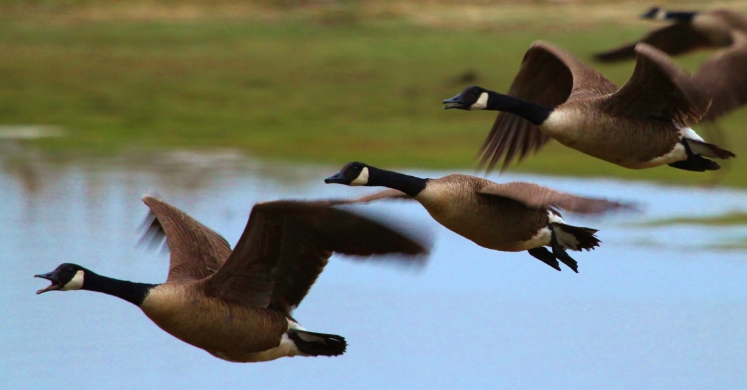Blog

#bioPGH Blog: On the Wings of Migration
 A resource of Biophilia: Pittsburgh, #bioPGH is a weekly blog and social media series that aims to encourage both children and adults to reconnect with nature and enjoy what each of our distinctive seasons has to offer.
A resource of Biophilia: Pittsburgh, #bioPGH is a weekly blog and social media series that aims to encourage both children and adults to reconnect with nature and enjoy what each of our distinctive seasons has to offer.
This October may have been warm, but for many birds, fall migration is well underway! If you live near a ridgeline, you might have spotted birds of prey passing overhead on their way down south. Songbirds are harder to spot on their journey as they generally travel at night, but whether a bird has the little wings of a warbler or the seven-foot spans of a bald eagle, migratory birds must travel hundreds if not thousands of miles to reach their seasonal destination. Have you ever wondered how birds manage to fly such long distances? From energetics to body size ratios, there is quite a lot involved, but wing shape is a good place to start. Let’s explore!
Broadly speaking, there are five different categories of bird wings based on both shape and function. For birds that migrate long distances over land, passive soaring wings are the ticket. These wings have a wide wingspan in comparison to their body and elongated flight feathers suited to either catching thermals (rising columns of warm air) or orographic lift, which occurs when wind hits the side of a mountain, bluff, or ridge and travels upwards. Passive soaring wings can “ride” either of these wind drafts for long distances in ideal conditions, minimizing the amount of energy spent flapping. Examples of birds with passive soaring wings are hawks and such majesties as golden eagles and bald eagles. (If you’re hoping to spot one overhead this season, check out the Allegheny Front, a part of their migratory corridor!)
Let’s say you’re a bird with a need for speed, high speed wings are your answer! These wings are long, slim, and pointed, which allows them exceptional speed without necessarily expending exceptional energy even while flapping. In fact, the fastest animals in the world have this wing shape. Peregrine falcons can dive at up to 200 miles per hour, far outstripping the fastest land animal, the cheetah, who can *only* sprint at 60-70 miles per hour. It might also be surprising to note that some ducks are among the fastest birds in the world with their high speed wings. The eider duck, for example, has been documented flying level just shy of 50 miles per hour.
For birds that travel longs distances over water, active soaring wings dominate. Birds with active soaring wings take advantage of the wind above currents of water with slender wings that are noticeably longer than that of high speed birds. To take advantage of any possible breeze, active soaring birds often seem to fly in a zigzag or up and down pattern. The trick works, though, as birds such as albatross can travel for miles at a time without a single beat of their wings!
Other wing shapes that seem less ideal for long distance travel are elliptical wings and hovering wings. Many of Pennsylvania’s year-round resident birds have elliptical wings—elliptical referring to the shape of their wings if you were to view them from above fully extended (it’s almost as though someone took opposites sides of a circle and pulled them outwards). Elliptical wings are good for maneuverability and short bursts of speed, but long distance migrants typically need longer wings to sustain their flight. Hovering wings, from such wing-beat masters as hummingbirds, may not be the most obvious choice for migration with their small size, but our ruby-throated hummingbirds still migrate all the way from their Pennsylvania breeding grounds to their wintering grounds in Central America. These birds do leave Pennsylvania in very early fall, which makes sense given the distance they have to travel.
It should be noted, however, that there are always exceptions in nature, and it is humans that want to make categories. Not all birds fit neatly into one category or another, which is perfectly fine. The categories are only there for us to better understand the natural history of birds a bit better. When it comes to flight, there are many factors to consider, such as a bird’s body weight to wing length ratio, the cross sectional shape of their wings (called the airfoil), feathering, and so on. There is so much to learn! It’s part of what makes nature exciting!
Connecting to the Outdoors Tip: The PA DCNR has a list of the best birding spots in Pennsylvania, many of them within an easy drive of Pittsburgh. Also, now is the perfect time to start thinking about getting involved in one of the Audubon's annual bird counts in December. Focused on winter residents, the bird counts are organized all over the country and are a perfect time to learn from local experts about the kinds of birds in your area.
Continue the Conversation: Share your nature discoveries with our community by posting to Twitter and Instagram with hashtag #bioPGH, and R.S.V.P. to attend our next Biophilia: Pittsburgh meeting.
Resources
The Academy of Natural Sciences at Drexel University: Bird Flight
Cornell Lab of Ornithology: Birds and their Wing Shapes
BBC: The Reasons Why Bird Wings Are so Amazing
Royal Society for the Protection of Birds: What is the Fastest Bird in Level Flight?
Photo Credit: Wikimedia users Bear Golden Retriever and Tony Hisgetta CC-BY-2.0

